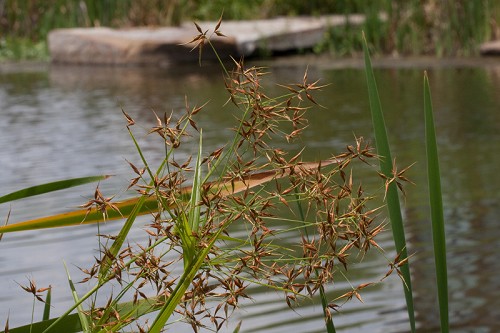Rhynchospora corniculata
Common name: short-bristled horned beaksedge [1]
| Rhynchospora corniculata | |
|---|---|

| |
| Photo by John Gwaltney hosted at Southeastern Flora.com | |
| Scientific classification | |
| Kingdom: | Plantae |
| Division: | Magnoliophyta - Flowering plants |
| Class: | Liliopsida – Monocotyledons |
| Order: | Poales |
| Family: | Cyperaceae |
| Genus: | Rhynchospora |
| Species: | R. corniculata |
| Binomial name | |
| Rhynchospora corniculata Lam. | |

| |
| Natural range of Rhynchospora corniculata from USDA NRCS Plants Database. | |
Contents
Taxonomic Notes
Synonyms: Rynchospora corniculata, orthographic variant
Varieties: R. corniculata' var. interior Fernald
Description
R. corniculata is a perennial graminoid of the Cyperaceae family native to North America.[2]
Distribution
R. corniculata is found in the southeastern corner of the United States.[2]
Ecology
Habitat
R. corniculata proliferates in pondcypress savannas in Carolina bays, swamp forests, and other wetlands.[1] Specimens have been collected from moist loam, shaded mucky soil, floodplain swamp, shaded river bank, bottomland woods, marshy creekbed, edge of water in dense pine canopy, and upper tidal swamp of mixed forest.[3]
Rhynchospora corniculata is an indicator species for the Panhandle Seepage Savannas community type as described in Carr et al. (2010).[4]
Phenology
R. corniculata has been observed flowering in July and September.[5]
Fire ecology
R. corniculata is not fire resistant, but has a medium fire tolerance.[2]
Conservation and Management
R. corniculata is listed as threatened by the Indiana Department of Natural Resources Division of Nature Preserves, and as a weedy or invasive species by the Southern Weed Science Society. [2]
Cultivation and restoration
Photo Gallery
References and notes
- ↑ 1.0 1.1 Weakley, A. S. (2015). Flora of the Southern and Mid-Atlantic States. Chapel Hill, NC, University of North Carolina Herbarium.
- ↑ 2.0 2.1 2.2 2.3 USDA Plant Database https://plants.usda.gov/core/profile?symbol=RHCO2
- ↑ URL: http://herbarium.bio.fsu.edu. Last accessed: June 2018. Collectors: Loran C. Anderson, R.K. Godfrey, R.F. Doren, R.Komarek, R.A. Norris, R. Kral, Richard Mitchell, Madel Kral, Sydney T. Bacchus, Deborah R. Shelley, P.L. Redfearn, Sidney T. Brinson, W. Miley, C.S. Giddeen, A. Redmond, K. Craddock Burks, Cecil Slaughter, Annie Schmidt, Travis MacClendon, Chris Buddenhagen, Becky Lee, M. Darst, H. Light, J. Good, L. Peed. States and counties: Florida (Leon, Wakulla, Jefferson, Marion, Gadsden, Liberty, Holmes, Nassau, Jackson, Citrus, Seminole, Escambia, Okaloosa, Madison, Osceola, Santa Rosa, Dixie) Georgia (Atkinson, Thomas)
- ↑ Carr, S.C., K.M. Robertson, and R.K. Peet. 2010. A vegetation classification of fire-dependent pinelands of Florida. Castanea 75:153-189.
- ↑ Nelson, G. PanFlora: Plant data for the eastern United States with emphasis on the Southeastern Coastal Plains, Florida, and the Florida Panhandle. www.gilnelson.com/PanFlora/ Accessed: 29 MAY 2018